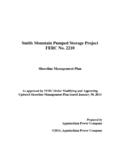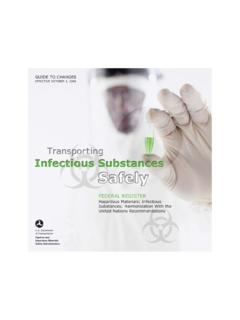Transcription of Piedmont Plateau - Smith Mountain Project
1 2/28/2008 7:48 AM Page 1. Do not collect plants from the wild Buy nursery-propageted plant material Help prevent establishment of non-native species in natural communities FOR MORE INFORMATION ON NATIVE PLANTS: Virginia Department of Conservation and Recreation Natural Heritage Program 217 Governor Street Richmond, VA 23219. (804) 786-7951. For a list of nurseries that propagate native plants: Virginia Native Plant Society 400 Blandy Farm Lane, Unit 2. Boyce, VA 22620. (540) 568-8679. For a list of nurseries in a particular region of Virginia contact: The Virginia Nurseryman's Association*. 383 Coal Hollow Road Christiansburg, VA 24062-0278.
2 (540) 382-0943. *List includes association members only. ABOUT THE Project . This Project is the result of a collaboration between the Virginia Department of Conservation and Recreation and the Virginia Native Plant Society and was made possible by a grant from the National Fish and Wildlife Foundation. Funds were also contributed by the Virginia Nurseryman's Association, the Virginia Chapter of the American Society of Landscape Architects and the Lewis Ginter Botanical Garden. In addition to those three organizations, the spon- sors extend their considerable appreciation to the other col- laborators who provided valuable advice and assistance throughout the life of the Project .
3 The Nature Conservancy-Virginia Chapter Virginia Polytechnic Institute and State University, Department of Horticulture Virginia Department of Agriculture and Consumer Services Virginia Department of Forestry Virginia Department of Game and Inland Fisheries Virginia Department of Transportation Project participants share a commitment to protect native plant habitats, especially those that support rare, threatened or endangered species. The use of native plant species, especially plants propagated from local populations, in land management, conservation, restoration and horticultural projects will help maintain the ecological integrity of natural areas and preserve native biodiversity.
4 12/01. Piedmont Plateau 2/28/2008 7:48 AM Page 2. OUR NATURAL HERITAGE. Native wildflowers, shrubs and trees are natural heirlooms, handed down to us from a time before recorded history. Using native plants in even the smallest garden can create miniature landscapes possessing the charm and character unique to a region's natural history. With some simple changes, our traditional lawns and gardens can expand to include these local heirlooms, providing us with beauty, sol- ace and conversation, as well as contributing to the conser- vation of native species. Indeed, landscaping with native plants, whether in a pri- vate garden, on commercial property or in public parks, will help to preserve species.
5 Natural habitats for some of our native plants are rapidly being lost. But there are other rea- sons for planting native wildflowers, grasses, ferns, shrubs and trees: They can match the finest cultivated plants in beauty and may surpass them in ruggedness and resist- ance to insects and diseases. Native: species naturally occurring in the region in which they evolved (indigenous). Alien: species introduced to a new region by humans, either deliberately or accidentally (exotic, non-native). WHAT ARE NATIVES? Native species are those that occur in the region in which they have evolved. Plants and animals evolve in specific habitats over extended periods of time in response to physi- cal and biotic processes that are characteristic of that place: the climate; the soils; the seasonal rainfall, drought, and frost; and interactions with other species occupying those habitats.
6 They thus possess certain traits that make them uniquely adapted to local conditions. In North America, plants are considered to be native if they occurred here prior to European settlement. This dis- tinction is made because of the many changes in the flora that have occurred since the arrival of European settlers. Since then many more plants have been deliberately and accidentally introduced to North America from distant shores. But alien species do not come only from distant coun- tries. They may be introduced from a different region of the same country. For instance, a species native to the forests of the west coast of North America would be considered alien if found on the east coast where it was not a constituent of the regional flora.
7 NATIVES VS. ALIENS. While many alien plants are beneficial and have little or no effect on the natural environment, a few invasive alien species pose serious threats to both natural communities and rare species. Because of a lack of natural controls like insect pests and competitors, some alien plants are able to escape our gardens, establish in a new area, then displace the native plant species growing there. What was a finely woven and diverse natural community may become a monoculture dominated by the invasive alien plant. Along with the displacement of native plant species from these natural habitats comes the loss of many flying, crawling and burrowing creatures that relied on native plants for food, cover and shelter.
8 2/28/2008 7:48 AM Page 3. In contrast to invasive alien species, other non-native plants are unable to thrive without extra effort by gardeners. For instance, they may originate in regions with abundant rainfall and soils rich in nutrients. If then introduced into a drier region with less fertile soils, they may require addition- al watering and fertilizer. The natural defenses that plants evolve in their original habitats may not protect them in a new environment, requiring the application of pesticides to aid their growth. The benefit of growing plants within the region in which they evolved is that they are more likely to thrive under the local conditions requiring less attention, labor and expensive additives.
9 BASICS ABOUT. LANDSCAPING WITH NATIVES. When landscaping with natives, match the plants to the cor- rect region, moisture and light conditions. Start with this brochure and study the names of the plants native to your region, and the sunlight and moisture regimes they prefer. Refer to field guides and books of natural history to learn which plants will fit within your planting scheme and provide specific benefits to the wildlife in your area. Plan to texture your landscape with a combination of flowers, shrubs and trees that would occur together naturally. Visit a natural area in your region and observe common plant associations, spatial groupings and habitat conditions.
10 Whether you start small or go all out, always purchase your native plants and seeds from reputable sources that propagate their own plants, preferably from local sources. NATIVES FOR WILDLIFE. Plants and animals evolve together to create unique natural communities, weaving a complex web of interrelationships. Flowers often bloom and fruits ripen in synchrony with the needs of the animals that pollinate the flowers and disperse the seeds. A butterfly feeds on the nectar of a certain flower and in turn pollinates the plant. To reap the greatest benefit, the flower must bloom and the butterfly emerge simultane- ously. Later the flower goes to seed, coincidentally when songbirds are fattening for the autumn migration.






